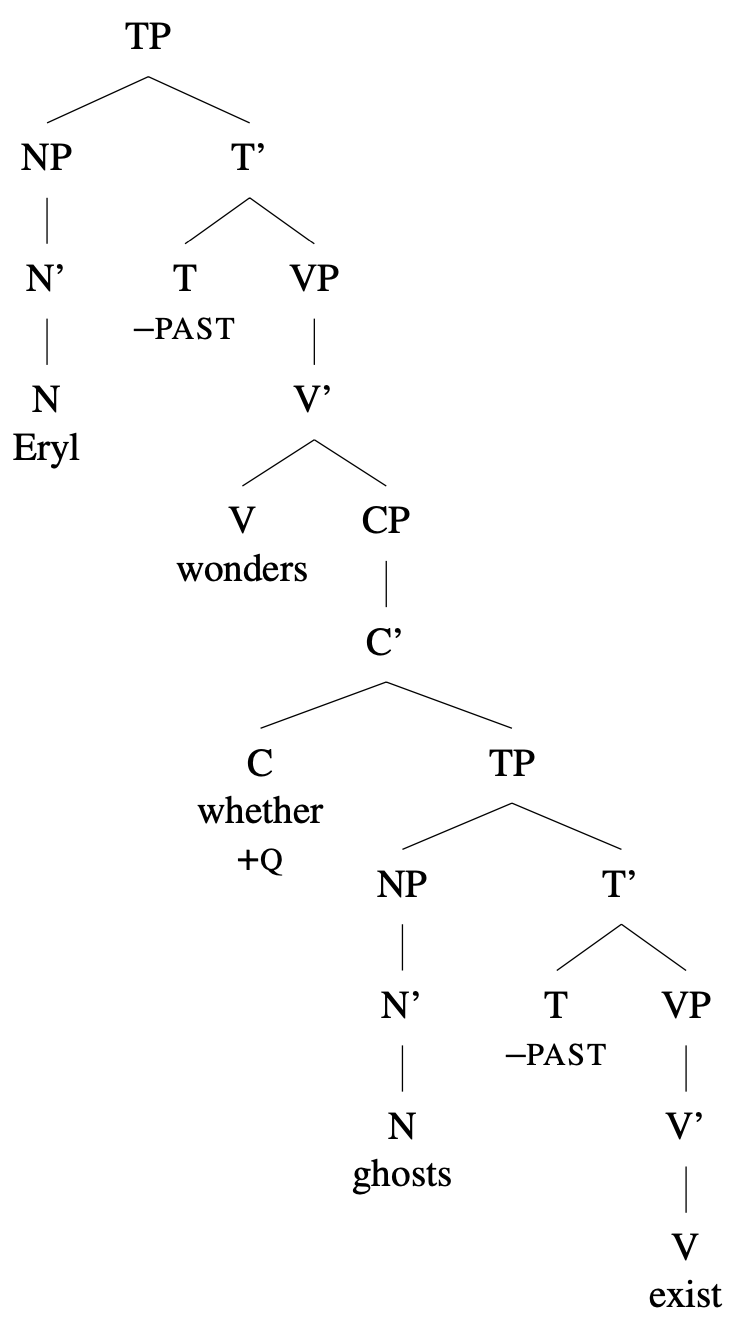

In Section 6.6 we observed that complementizers allow clauses to be embedded—that is, to be complements of a verb. Following our principles of X-bar structure, this means that the complementizer (C) must project a CP. Because verbs can select whether they take an embedded clause, this CP should be the complement of the verb, and should take TP as its own complement. Recall the sentences we looked at in Section 6.6:
| (1) | Deniz said something. |
| (2) | Samnang might leave. |
![Tree diagrams: [TP Deniz [VP [V said] [NP something]]] and [TP Samnang might leave]](https://socialsci.libretexts.org/@api/deki/files/131155/618_tree1_twoTPs.png?revision=1)
Based on the principle of X-bar theory we have seen in previous sections, these would correspond to the tree structures in Figure 6.24. Now we can ask: how do these two clauses fit together when (2) is embedded below the verb said of (1), as in the complex sentence in (3)?
| (3) | Deniz said that [Samnang might leave]. |

In addition to what we said in previous sections about the fact that some verbs select CPs as their complements, here’s no space to put the C head, or the CP it’s part of, within either the embedded TP to the main clause VP. Instead, we put the TP inside the CP, as in the tree in Figure 6.25. What if the complementizer [C that ] is missing, as in (4)?
| (4) | Deniz said that [Samnang might leave]. |
In this case we’d wouldn’t say that there’s no CP, but that in English the C head can be null. (In Section 6.19 we’ll see other cases where we assume there is an empty C head, because its specifier position is filled.) The tree for (4) would be just like the tree in Figure 6.25, but with no word in the C head. In Section 6.6 we saw that embedded Yes-No questions are structurally similar to embedded declaratives, but with the complementizer if or whether. Since they have similar structures, their trees are also fundamentally the same, with if or whether occurring in a C head. Thus the tree for a sentence like (5) is as in Figure 6.26.
| (5) | Eryl wonders if [ghosts exist]. |

In 6.6 Clausal embedding we introduced the feature [–Q] for declarative complementizers and [+Q] for interrogative complementizers. Reframing this in terms of C heads, both that and ∅ are declarative C heads with a [–Q] feature, while both if and whether are interrogative C heads with a [+Q] feature. Verbs select whether they compose with [–Q] CPs, [+Q] CPs, both, or neither. Finally, in section 6.6 we also introduced embedded nonfinite clauses. The complementizer in these clauses is either ∅ or for, which we could call [–FIN] complementizers. They also differ in that the head of T is the nonfinite marker to.
| (6) | I want for [ghosts to exist]. |

We’ve now finished formalizing the basic structure of clauses in X-bar theory. Our next step will be to look at how we can formalize transformations in tree structures, introducing the concept of syntactic movement.
If you are following the alternative path through this chapter that interleaves core concepts with tree structures, the previous section was 6.6 Clausal embedding, and the next section is 6.7 Main clause Yes-No questions.
This page titled 5.9: Trees- Embedded clauses is shared under a CC BY-NC-SA 4.0 license and was authored, remixed, and/or curated by Catherine Anderson, Bronwyn Bjorkman, Derek Denis, Julianne Doner, Margaret Grant, Nathan Sanders, and Ai Taniguchi (eCampusOntario) via source content that was edited to the style and standards of the LibreTexts platform.